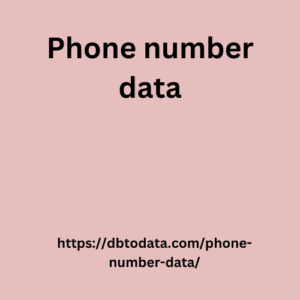Crafting a Sales Forecast Budget Article: A 5-Paragraph Guide
Heading 1: Understanding the Importance of Sales Forecasting
Sales forecasting is a cornerstone of effective business planning. It involves predicting future sales revenue based on historical 100% Active Hong Kong Phone Number List data, market trends, and other relevant factors. A well-crafted sales forecast provides a solid foundation for budgeting, resource allocation, and strategic Hong Kong Phone Number Library decision-making.
Heading 2: Key Components of a Sales Forecast Budget
A comprehensive sales forecast budget typically includes the following elements:
- Historical Sales Data: Analyzing past sales performance helps identify seasonal patterns, trends, and growth rates.
- Market Research: Understanding market conditions, competition, and customer behavior is crucial for accurate forecasting.
- Sales Team Input: Gathering insights from sales representatives can provide valuable information on potential deals, pipeline activity, and customer sentiment.
- Economic Indicators: Economic factors such as GDP, inflation, and interest rates can significantly impact sales.
- Sales Strategies: Evaluating the effectiveness of current sales strategies and planned initiatives can influence forecast accuracy.
Heading 3: Popular Forecasting Methods
Several methods can be employed to create sales forecasts, each with its own advantages and drawbacks:
- Time Series Analysis: This method uses historical data to identify patterns and trends over time.
- Regression Analysis: Regression models can be used to predict sales based on relationships between variables.
- Market Basket Analysis: This technique analyzes the products or services . That are frequently purchased together to identify potential cross-selling opportunities.
- Causal Modeling: Causal models consider the impact of specific factors on sales, such as marketing campaigns or economic conditions.
Heading 4: Building a Sales Forecast Budget
Once the forecasting method is selected, the following steps can be followed to create a sales forecast budget:
- Gather Data: Collect relevant historical data, market research, and sales team input.
- Choose a Forecasting Method: Select the most appropriate method based on the data and business objectives.
- Develop the Forecast: Apply the chosen method to create a detailed sales forecast, including monthly, quarterly, and annual projections.
- Analyze and Adjust: Review the forecast for accuracy and make necessary adjustments based on new information or changing circumstances.
Heading 5: Using the Sales Forecast Budget for Decision Making
A well-constructed sales forecast budget can be a valuable tool for informed decision-making. It can help businesses:
- Allocate Resources Effectively: By Buy Canada WhatsApp Number Database understanding future sales projections, businesses can allocate resources such as staffing, inventory, and marketing expenses more efficiently.
- Set Realistic Goals: A sales forecast provides a benchmark for setting achievable sales targets and performance expectations.
- Identify Potential Risks and Opportunities: Analyzing the forecast can help identify potential risks, such as declining sales or increased competition, and uncover opportunities for growth.
- Improve Business Planning: The sales forecast budget can be integrated into the overall business plan, providing a foundation for strategic decision-making.
By following these guidelines and utilizing effective forecasting methods, businesses can create accurate sales forecast budgets that support growth, profitability, and long-term success.


